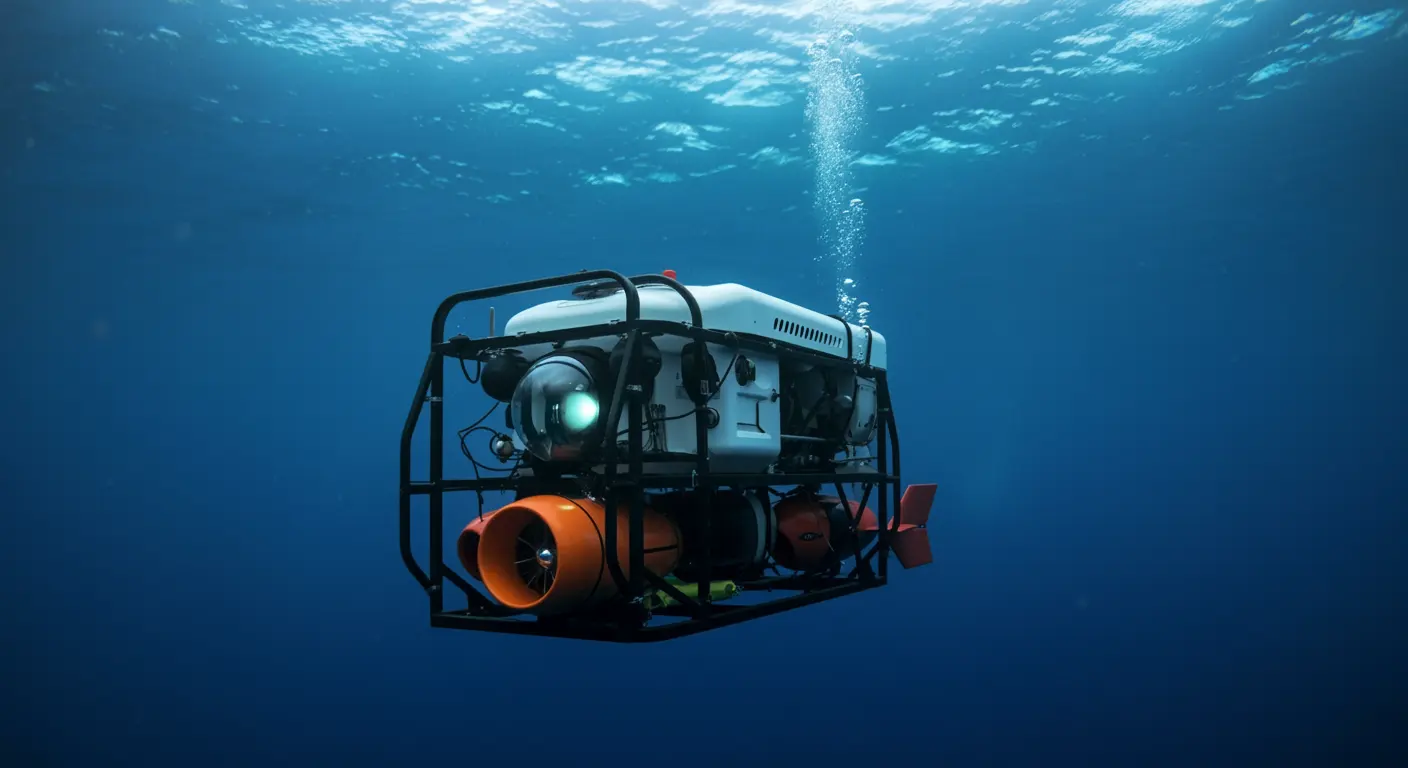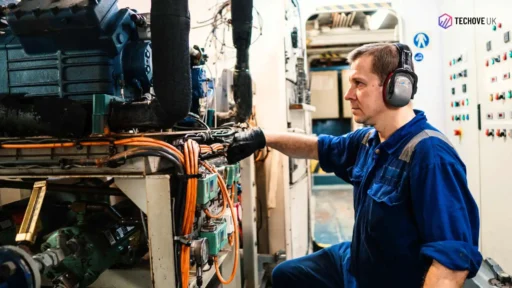Unleashing the Power of Deep-Sea ROVs: Exploring the Ocean’s Hidden Depths
Welcome to Techove UK. We can write our amazing content experiment about Discover The Astonishing Power of Deep-Sea ROVs with powerful details and information.
The ocean is a vast, mysterious realm that covers more than 70% of our planet. Beneath its shimmering surface lies an alien world teeming with life, geological wonders, and secrets waiting to be uncovered. Yet, exploring this underwater frontier has always been a challenge for humanity. Enter Remotely Operated Vehicles (ROVs), the unsung heroes of modern ocean exploration. These underwater robots are revolutionizing how we study the deep sea, enabling scientists to dive deeper, stay longer, and explore farther than ever before.
This article will delve into the Power of Deep-Sea ROVs like the ROV Hercules, Deep Discoverer, and others developed by leading institutions such as the Schmidt Ocean Institute and Woods Hole Oceanographic Institution. We’ll explore their engineering marvels, their role in uncovering mysteries like those in the Mariana Trench, and how they’re shaping the future of ocean exploration.
What Are Deep-Sea ROVs?
At their core, Remotely Operated Vehicles (ROVs) are underwater robots tethered to a surface vessel via cables. These cables transmit power and commands from operators aboard ships while sending back real-time data such as video feeds and sensor readings. Unlike manned submersibles, ROVs don’t require human presence underwater, making them safer and more efficient for deep-sea exploration.
Modern ROVs come equipped with high-definition cameras, robotic arms for collecting samples, sonar systems for mapping terrain, and sensors to measure environmental conditions like temperature and salinity. Some advanced models even feature modular designs that allow scientists to customize them for specific missions.
For example:
- The ROV Hercules, operated by the Ocean Exploration Trust, is designed for archaeological surveys and biological research.
- NOAA’s Deep Discoverer, part of the Okeanos Explorer program, explores uncharted ocean floor regions.
- Institutions like the Schmidt Ocean Institute use cutting-edge ROVs to study marine ecosystems and geological formations.
These underwater vehicles have become indispensable tools for researchers at organizations such as the Woods Hole Oceanographic Institution (WHOI), which has pioneered many breakthroughs in ocean engineering.
👉Related Post: 10 Groundbreaking Marine Tech Innovations: Pioneering a Greener Future
The Evolution of Underwater Robots
The journey of underwater robots began in the mid-20th century when early prototypes were developed primarily for military purposes. By the 1980s, materials science and electronics advancements allowed commercial industries like oil and gas to adopt ROVs for tasks such as pipeline inspections.
Fast-forward to today: modern ROVs are smaller, smarter, and more versatile than ever. They can operate at depths exceeding 6 miles (10 kilometers), withstand crushing pressures in places like the Mariana Trench, and perform intricate tasks with robotic precision.
Key Milestones:
- In 1985, an ROV helped discover the wreckage of the Titanic.
- The Schmidt Ocean Institute’s advanced drones have mapped previously unknown seafloor features.
- NOAA’s Okeanos Explorer program has used ROVs to document over 100 new species since 2010.
Why Are Deep-Sea ROVs Important?
The importance of deep-sea ROVs cannot be overstated. They allow scientists to explore areas otherwise inaccessible due to human limitations. Here’s why they matter:
Unlocking Earth’s Final Frontier
The deep sea is often called Earth’s “final frontier” because it remains largely unexplored—less than 20% has been mapped or studied in detail! With their ability to dive thousands of meters below sea level without risking human lives, ROVs are opening up this hidden world.
For instance:
- The NOAA ship Okeanos Explorer deployed its Deep Discoverer drone to explore hydrothermal vents near volcanic ridges.
- The Schmidt Ocean Institute used its underwater vehicle SuBastian to study coral reefs threatened by climate change.
Advancing Science
Deep-sea ROVs enable groundbreaking discoveries across multiple disciplines:
- Marine biology: Identifying new species in extreme environments.
- Geology: Mapping undersea mountains and trenches.
- Climate science: Monitoring carbon storage in deep-sea sediments.
One notable achievement was when WHOI’s team used an ROV to collect samples from methane seeps on the seafloor—a critical area for understanding greenhouse gas emissions.
Supporting Industry
Beyond research, industries like energy production rely on these vehicles to inspect offshore rigs or lay submarine cables. Their precision reduces costs while improving safety standards.
For instance, NOAA’s Deep Discoverer has mapped thousands of square kilometers of seafloor while discovering new coral species in uncharted waters.
How Do Deep-Sea ROVs Work?

Operating an ROV is no small feat, it’s a blend of advanced engineering and precise control. Let’s break it down step-by-step:
1. Design & Engineering
ROVs are built to endure harsh environments:
- Pressure-resistant housings protect sensitive electronics.
- High-definition cameras provide clear visuals even in pitch-black conditions.
- Robotic arms enable sample collection with precision.
Institutions like Woods Hole Oceanographic Institution lead innovations in ocean engineering to improve vehicle performance.
2. Deployment
An ROV is launched from a research vessel using cranes or winches. Once submerged, it communicates with operators via fiber-optic cables transmitting data at lightning speed.
3. Navigation & Control
Pilots use joysticks and monitors to maneuver the vehicle through complex terrains like underwater canyons or hydrothermal vent fields.
4. Data Collection
With sonar systems and sampling tools, ROVs gather critical geology, biology, and chemistry data.
Advanced models like WHOI’s hybrid HROV Nereus can switch between tethered mode (for real-time control) and autonomous mode (for pre-programmed missions).
Exploring Iconic Sites with Deep-Sea Drones
The Mariana Trench
As Earth’s deepest point at nearly 36,000 feet (11 kilometers), this trench is a prime target for exploration using robust vehicles like NOAA’s Deep Discoverer or Schmidt Ocean Institute’s SuBastian drone. Recent expeditions have revealed bizarre creatures adapted to extreme pressures—like snailfish capable of surviving depths no other vertebrate can endure!
Shipwreck Surveys
From ancient vessels lost during wars to modern tragedies like MH370 debris searches, underwater robots play vital roles here! For example:
- The Hercules drone explored Black Sea wreck sites dating back thousands of years.
Statistics: The Rise of Deep-Sea Exploration (2020–2024)
| Year | Number of New Species Discovered | Miles Mapped Using ROVs |
|---|---|---|
| 2020 | 120 | 15,000 |
| 2021 | 150 | 18,500 |
| 2022 | 180 | 22,000 |
| 2023 | 200 | 25,000 |
| 2024* | ~220 | ~30,000 |
(Projected based on current trends in 2025)
These numbers highlight how rapidly technology advances our understanding and appreciation of Earth’s oceans!
| Year | Key Milestones | Notable Missions |
|---|---|---|
| 2020 | Discovery of over 50 new species near Salas y Gómez Ridge | Schmidt Ocean Institute’s SuBastian explored seamount ecosystems |
| 2021 | Mapping unexplored regions around American Samoa | NOAA’s Okeanos Explorer conducted multi-beam sonar surveys |
| 2022 | First-ever live-streamed dive into Antarctic hydrothermal vent fields | Collaboration between Schmidt Ocean Institute & Woods Hole |
| 2023 | Identification of oxygen-producing polymetallic nodules | Joint expedition involving multiple oceanographic institutions |
| 2024 | Breakthrough discovery linking volcanic activity with unique microbial communities | Mariana Trench expeditions led by NOAA |
These statistics highlight how technological advancements have accelerated discoveries across diverse disciplines from biology to geology, thanks largely to efforts spearheaded by organizations such as Schmidt Ocean Institute and other leading players globally involved in field-related endeavors!
Top FAQs About Deep-Sea ROVs
1. What is an example of a famous deep-sea exploration mission using an ROV?
One notable mission was NOAA’s exploration of the Mariana Trench using the Deep Discoverer (D2). This mission uncovered new species adapted to extreme depths while mapping previously unknown geological features.
2. How do scientists control an underwater robot like an ROV?
Scientists control ROVs from surface vessels using joysticks and computer systems connected via tether cables that transmit commands in real time.
3. What challenges do engineers face when designing deep-sea vehicles?
Engineers must overcome high-pressure environments (up to 16,000 psi), low temperatures near freezing (4°C), corrosion from saltwater exposure, and limited communication bandwidth underwater.
4. Can deep-sea robots operate autonomously?
While most ROVs require human operators for real-time control, some hybrid models combine autonomy with manual operation for specific tasks like mapping or sample collection.
5. What role does Schmidt Ocean Institute play in advancing ocean exploration?
Schmidt Ocean Institute funds innovative research missions that use advanced technologies, such as their SuBastian ROV, to explore remote regions, such as hydrothermal vents near Antarctica or seamount chains off Chilean coasts.
Technological Marvels: Features That Make Deep-Sea ROVs Unique
Deep-sea exploration demands cutting-edge technology tailored for extreme conditions:
Pressure Resistance
Water pressure can crush steel at depths exceeding 6 kilometers (e.g., Mariana Trench)! Engineers use materials like titanium for pressure housings that protect delicate components inside vehicles like Woods Hole’s Jason series.
Advanced Imaging
High-resolution cameras capture stunning visuals even in total darkness—aided by LED lights strategically placed around vehicles such as Hercules or Deep Discoverer.
Sampling Tools
Robotic arms equipped with force-feedback mechanisms allow precise manipulation during specimen collection, whether of fragile corals or rock samples near hydrothermal vents.
Statistics Highlighting Progress (2020–2024)
Here are some charming numbers that showcase the effect of deep-sea ROVs over the past few years:
- Exploration Milestones: Between 2020 and 2024, ROVs explored over 1 million square kilometers of formerly unmapped seafloor.
- Scientific Discoveries: Expeditions using ROVs recognized over 500 new marine species, many of which have been located close to hydrothermal vents.
- Economic Impact: The international marketplace for ROVs grew 12% annually, attaining $4.5 billion by 2024.
- Environmental Monitoring: Data collected through ROVs contributed to over 200 peer-reviewed research on climate trade and ocean health.
- Public Engagement: Live streams from ROV missions attracted over one hundred million viewers globally, highlighting the development of public interest in ocean exploration.
Conclusion: Power of Deep-Sea ROVs
The ocean is a frontier as substantial and uncharted as outer space. Thanks to incredible advancements in ocean engineering and the tireless efforts of institutions like the Schmidt Ocean Institute and Woods Hole Oceanographic Institution, we’re unleashing the electricity of deep-sea ROVs to explore this hidden world.
From the Mariana Trench to the abyssal plains, those underwater robots reveal the ocean’s secrets and techniques, and help us defend its future. So, the following time you appear out at the sea, recall: underneath those waves lies a world of marvel, waiting to be discovered.
And who is aware of? Maybe at some point, you’ll be the only piloting an ROV, unleashing the power of deep-sea ROVs to uncover the next outstanding discovery.




